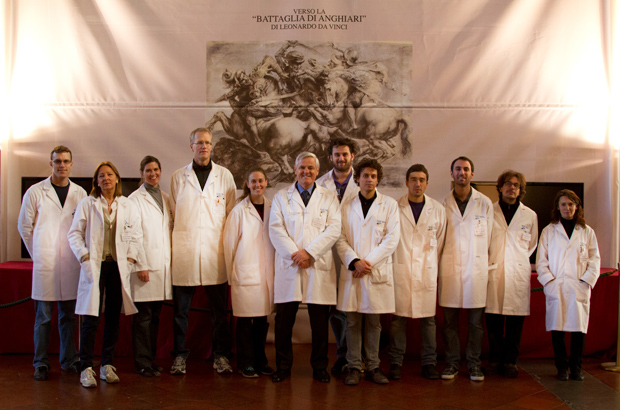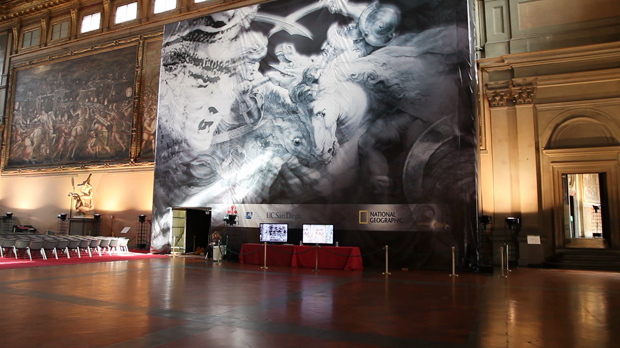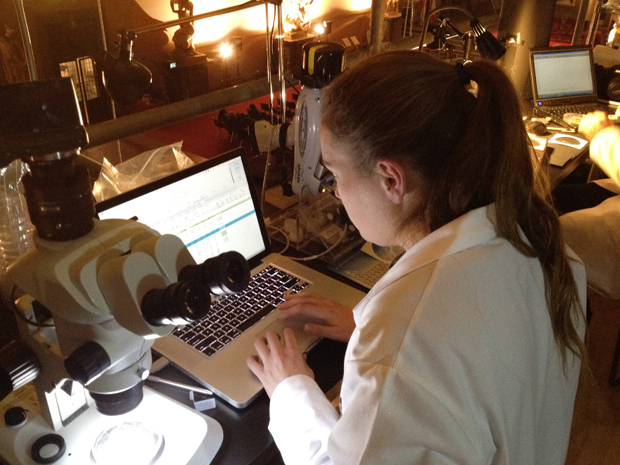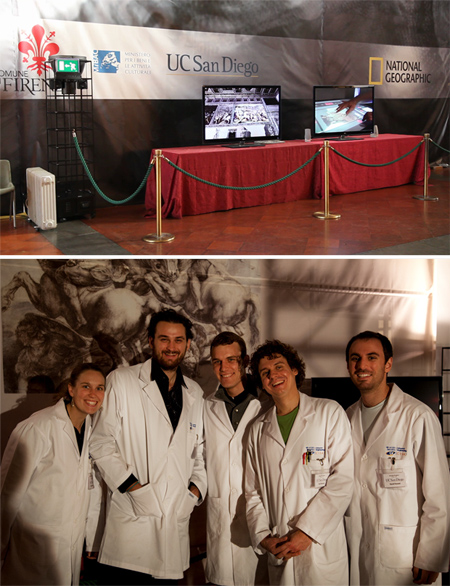
By:
- Raymond Hardie
Published Date
By:
- Raymond Hardie
Share This:
UC San Diego in the Hall of the Lost Da Vinci

Maurizio Seracini, ’73 (center), standing with the entire research team in front of the scaffold covering the Vasari fresco.
Why are the UC San Diego name and logo prominently displayed across one of the most famous walls in Florence? It is a story that starts more than five hundred years ago, when a Leonardo Da Vinci mural of the ‘Battle of Anghiari’ was painted on the wall of the Salone dei Cinquecento (the Hall of the Five Hundred).
According to Giorgio Vasari, in his Lives of the Artists, “It was ordained by public decree that Leonardo should be employed to paint some fine work,” to celebrate the new republic that had just driven the Medici family from power. “In 1503, the hall was allotted to him by Piero Soderini, the Gonfaloniere of Justice.” Da Vinci notes rather ominously in his own journal that he began to paint on June 6, 1505, just as a storm broke over the city and “great rain poured down until nightfall.”

The scaffold in front of the Vasari fresco in the Hall of the 500, Palazzo Vecchio.
But you won’t find the celebrated battle scene today; in its stead you will find another magnificent mural entrancing visitors, the ‘Battle of Marciano in Val di Chiana’ painted by Giorgio Vasari in 1563. However, we know that the Anghiari mural was still there in 1549, when Anton Francesco Doni wrote to a friend traveling to Florence: “Having ascended the stairs of the Salone Grande, take a diligent view of a group of horses (a portion of Leonardo’s battle), which will appear a miraculous thing to you.”
Ascend those same stairs today, and another “miraculous thing will appear to you.” That same portion of the wall now has a painted, cloth-covered scaffolding that stretches from floor to ceiling. It displays the proud message that this is a National Geographic and UC San Diego co-venture. And the venture is truly an adventure. It is an ongoing search by UC San Diego alumnus Maurizio Seracini for the lost Da Vinci mural, a search that has taken many twists and turns over the years and employed echographs, portable ground-penetrating radar, X-rays, stereomicroscopes and thermography.
Using the radar along the length and breadth of the Vasari mural, Seracini discovered that there was a gap, varying from 1- to 3-centimeters thick, between a newer brick wall and the original stone wall—large enough to preserve a mural on the hidden, older wall. He concluded that if Da Vinci’s work was there, it was almost certainly hidden behind the other magnificent mural that now entrances visitors, the ‘Battle of Marciano in Val di Chiana’ painted by Giorgio Vasari in 1563. But why would Vasari build a wall in front of the DaVinci and not paint over it? Da Vinci’s mural celebrated the victory of the Republic over the Medicis. When Cosimo de Medici returned to power, he commissioned Vasari to cover the politically embarrassing mural with a rendition of his own victory over Siena in 1554.

Samantha Stout, UCSD graduate student in materials science and engineering using light microscopy and x-ray fluorescence spectroscopy on the scaffold in the Salone dei Cinquecento.
“Vasari was a great admirer of Leonardo as we know from his Lives of the Artists,” Seracini says. “And he would have had no reason whatsoever to destroy the Leonardo’s mural. He had to place a wall in front of it since it represented a victory of the Republic of Florence.”
But another clue is even more enticingly mysterious. Seracini points out that there is a small battle flag amid a surging phalanx of pike men at the top of the Vasari mural that now covers the wall. The flag has two words, “Cerca Trova,” which translates as “He who seeks, finds.” It is a teasing epigram worthy of Dan Brown’s bestseller The Da Vinci Code. Seracini, a research professor at UC San Diego’s California Institute for Telecommunications and Information Technology (Calit2), is now seeking a solution to the five-hundred-year-old mystery with the backing of National Geographic.
When Seracini first started his search for the lost Da Vinci, he discovered that Vasari’s frescoes were painted on a brick wall built in front of an original stone wall. Then five years ago, using ground-penetrating radar, Seracini discovered a gap of 1 to 3 centimeters between the two walls. He concluded that Vasari had built the wall and left the gap to preserve the Da Vinci original.
In the last year, with the backing and expertise of UCSD’s Calit2, Seracini restarted the active search. He had planned to use a neutron activation device to bounce ions of the original stone wall, hoping to build a sketchy outline of what existed there from the individual pigment signatures that were collected. But that became politically impossible in Florence after the meltdown of Japan’s Fukushima Daichi reactor in the aftermath of the March 2011 earthquake and tsunami. In an atmosphere where any nuclear device was suspect, neutron activation was sidelined.

(Top Photo) Two video displays in the Hall of the 500 inform the 4,000 or so daily visitors about the innovative research being done at UC San Diego. (Bottom Photo) UCSD graduate students and staff engineers in front of the scaffold, L to R: Samantha Stout MSE, Tom Wypych CSE, Daniel Johnson Calit2 staff, Vid Petrovic CSE, David Vanoni CSE.
Then, in late January the LA Times reported: “Florence Mayor Matteo Renzi notified the team that he and local cultural officials had decided on a simple and fast way to solve the mystery — drilling holes in the Vasari and inserting tiny cameras into the gap between the walls.” Seracini was initially unsure, but then agreed to go ahead. Only six holes would be drilled and in areas where the plaster had already separated from the wall.
So, the search has been resumed, with Seracini and other researchers from UC San Diego’s Calit2 carefully working behind the cloth-covered scaffolding. As they probe Vasari’s masterpiece for the lost DaVinci, UC San Diego’s part in this cutting edge work is advertised across the front of the painted cloth and on the two large monitors looping videos on research at the campus. The university’s work has become a magnet for the three to four thousand tourists who visit the Salone dei Cinquecento each day, and are drawn to read about the university and its research. Da Vinci’s lost mural and UC San Diego together in Florence. Not a bad pairing. Vasari’s battle flag declares “Cerca Trova”- he who seeks, finds. With its reputation for discovery and innovation, it could also be the UC San Diego motto.
Share This:
You May Also Like
Stay in the Know
Keep up with all the latest from UC San Diego. Subscribe to the newsletter today.


